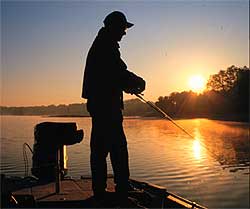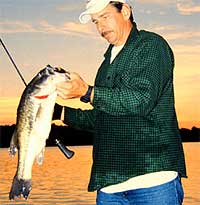Upstairs for Late-fall Bassin' Action
Upstairs for Late-fall Bassin' Action
By Bill Vanderford
Though only an orange glow filled the distant horizon from the not yet risen sun, enough light was available to see everything except what might be lurking in dimly-lit shadows. Bird noises were abundant and an occasional faraway splash broke the silence of the morning, so it was a perfect time to be out on a lake.
 The spinning rod made a whistling sound as it whipped through the cool morning air with enough speed to send the tiny topwater lure sailing toward an old fallen tree at the edge of the water. The angler allowed it to settle for a second as he took up the slack in his line and watched the circles from the splash become wider, then he gave the rod a little twitch. The Bill Lewis Spitfire made an audible "plopping" sound then.... all hell broke loose! The quiet surface erupted into millions of particles of spray as an over five pound bass exploded the surface while engulfing the tiny lure. That exciting beginning and the ensuing battle with the feisty black bass is why so many outdoors enthusiasts leave the crowded woods of today’s deer hunter to enjoy the serenity of fishing during the crispness of late-fall.
The spinning rod made a whistling sound as it whipped through the cool morning air with enough speed to send the tiny topwater lure sailing toward an old fallen tree at the edge of the water. The angler allowed it to settle for a second as he took up the slack in his line and watched the circles from the splash become wider, then he gave the rod a little twitch. The Bill Lewis Spitfire made an audible "plopping" sound then.... all hell broke loose! The quiet surface erupted into millions of particles of spray as an over five pound bass exploded the surface while engulfing the tiny lure. That exciting beginning and the ensuing battle with the feisty black bass is why so many outdoors enthusiasts leave the crowded woods of today’s deer hunter to enjoy the serenity of fishing during the crispness of late-fall.
Despite the fact that topwater fishing is not always the most efficient technique for catching bass, the adrenaline rush associated with surface strikes is still the ultimate bassin’ thrill! Plus, fishing on top is often the only way to catch a bass.
Though topwater lures are rarely fished during the coldest part of winter, bass will hit them most other times of the year. The rule of thumb is that the surface temperature of the water needs to be above 60 degrees. When bass are actively chasing baitfish, however, that rule may also be tabled.
During most of the year, time of day is important in deciding when to use surface lures, but other factors should also be considered along with the hour. If the day is sunny, topwaters are usually best early and late, when light penetration is low and shadows are long. On the other hand, if the sky is cloudy or drizzly, topwaters can produce all day long.
Stained water color usually has the same effect as an overcast sky. It reduces light penetration and bass tend to remain in shallower water. This is another condition in which topwaters may be used throughout the day. If the water turns muddy, however, topwaters lures are normally not the best choice.
 Wind is another consideration when using topwater lures. Most topwater experts prefer no wind early and late in the day, but when the sun is high, like to have a light ripple to break the surface. This causes the light to be refracted, which decreases its penetration and keeps the fish near the surface longer. Conversely, a strong wind with moderate to heavy chop is undesirable for fishing topwaters, since the movement and sound of the bait are diffused in the surface commotion.
Wind is another consideration when using topwater lures. Most topwater experts prefer no wind early and late in the day, but when the sun is high, like to have a light ripple to break the surface. This causes the light to be refracted, which decreases its penetration and keeps the fish near the surface longer. Conversely, a strong wind with moderate to heavy chop is undesirable for fishing topwaters, since the movement and sound of the bait are diffused in the surface commotion.
Where to fish topwaters is as important as when. One can either choose specific targets or cover general areas. This choice is often based on one’s casting ability.
Novice anglers should concentrate on larger areas of opportunity where precise casting is not an issue. These could include expanses of standing timber, underwater islands, steep creek channel banks, or riprap around dams or bridges. These places are hard to read for exact bass hideouts, therefore one must cover more water faster.
For those who possess excellent casting abilities, try precise casts toward specific structures. Examples of these might include blown down trees, exposed stumps, bridge pilings, boat docks, slightly exposed brush piles, or single standing trees. Bass around these structures will hold very close, so one should fish slower and with less commotion. When casting near any isolated object, however, the lure should strike the water beyond the structure and be retrieved so that it passes as near as possible to the intended target.
Popular Late-fall topwater lures come in many sizes and shapes, and each angler develops his or her own idea as to their use. When you get right down to the "nitty gritty", however, what usually attracts the bass is the same thing that intrigues the angler......noise! Topwater lures take advantage of the extraordinary sound and vibration sensing ability of bass, and fishermen enjoy the sudden blast and raucous show put on by the greedy predators. So, if you haven’t tried it, maybe it’s time for you to go upstairs for late-fall bassin’ action!
Bill Vanderford has won numerous awards for his writing and photography, and has been inducted into the Freshwater Fishing Hall of Fame as a Legendary Guide. He can be reached at 770-962-1241, at [email protected], or at his web site: www.fishinglanier.com.
|
